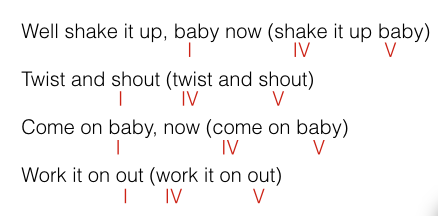
One of the ways to have a song be identified with a style is to be about a theme associated with the style. Another is to use familiar chords and progressions. There is a continuum in harmonic complexity, with country songs being the simplest and jazz the most complex.

Many blues, country, rock and roll, and folk songs use only I, IV, and V chords. The next richest scenario is to mix in the rest of the chords in the diatonic collection: ii, iii, and vi. The diminished vii° chord is not very commonly used.
Example: Red River Valley - traditional

Example: Twist and Shoult - John Lennon and Paul McCartney (The Beatles)

The next degree of harmonic complexity is to use add the rest of the diatonic chords. To the basic I, IV, and V chords you can add i, ii, iii, and vi.
The next degree of harmonic complexity is to add one or more secondary dominants. Secondary dominants are V or V7 dominant chords of other diatonic chords in key besides the I chord.
In C major C is the I chord. a G chord is the dominant V of C.
In C major Dm is the ii chord. The V7 chord in the key of D is A. The progression A7 to Dm in the context of C major could be analyzed as V/ii going to ii. The "/" slash is read as "of", and in this case you would say "Five of Two".
Secondary dominants in C major.
Minor keys can have two dominant chords: i ii° III iv V VI VII i
When the VII chord is followed by the III it sounds like V/III to III.
Here's the chorus from "Oops! I Did it Again". The contrast of the chorus with the bridge and a lot of the power comes from the high percentage of dominant chords and their resolutions to I and III (the relative major of C#m). [ score ]
| C#m | G# | C#m | B | E | B | E | B | G#/B# |
| i | V | i | V/III | III | V/III | III | VII | V |
| C#m | G# | C#m | B | E | G# | |||
| i | V | i | V/III | III | V |
Oops! I Did It Again - Max Martin and Rami Yacoub (Britney Spears)
1. Analyze this progression in the key of G:
G C D7 G B7 Em D7 G
2. Analyze this progression in the key of A:
A F#7 Bm D A
The next layer of harmonic complexity is to add borrowed chords, which we will study in the context of rock music.
Adding 9 chords and other extensions can create a jazzier feel, as in David Foster's "Through the Fire" sung by Chaka Khan.
[ Back to Index ]
| G | C | D7 | G | B7 | Em | D7 | G |
| I | IV | V7 | I | V7/vi | vi | V7 | I |
| A | F#7 | Bm | D7 | A |
| I | V7/ii | ii | V7 | I |